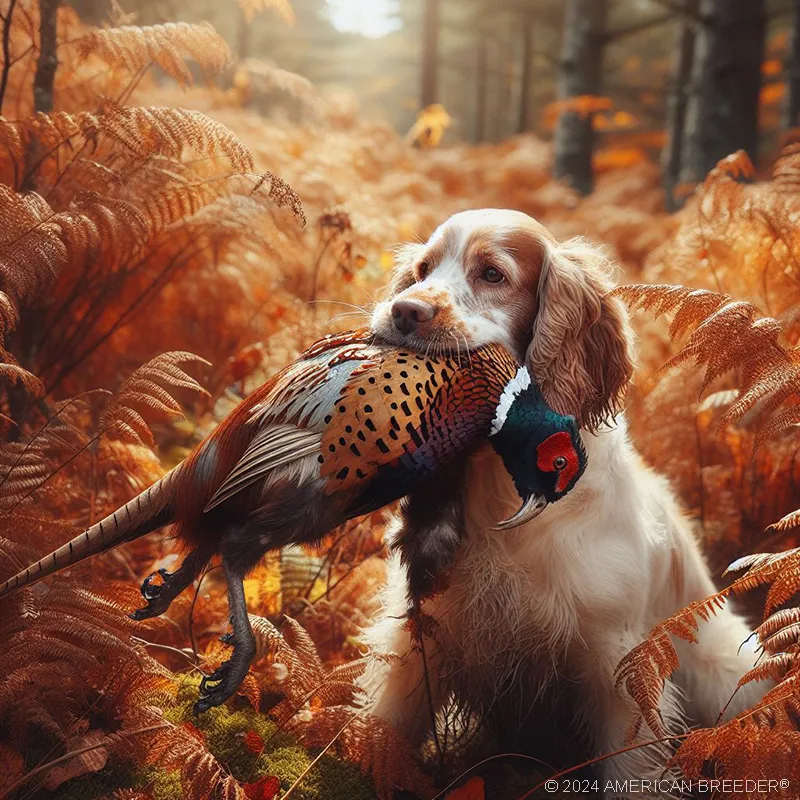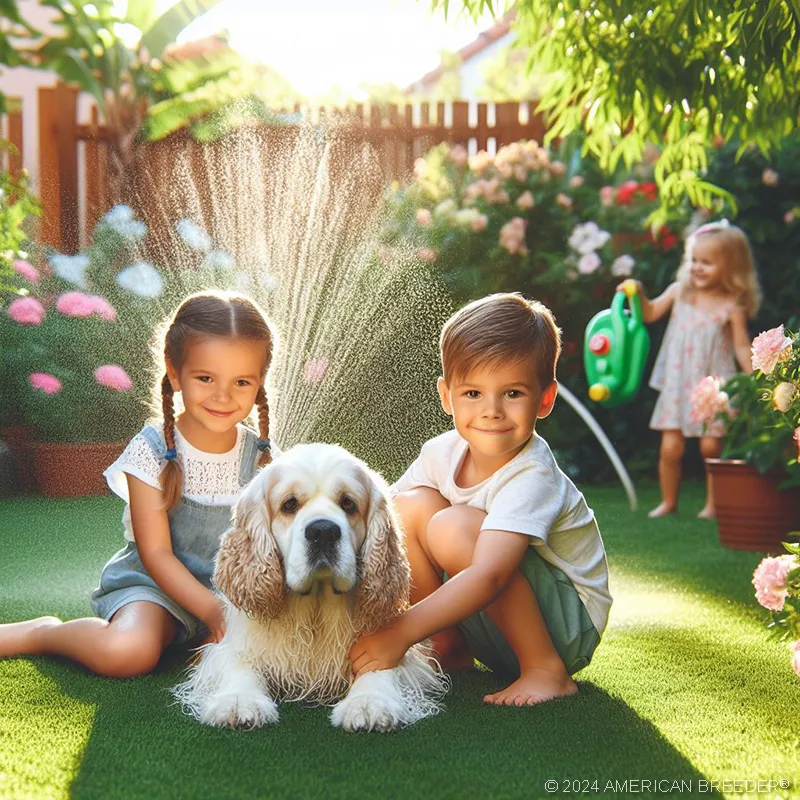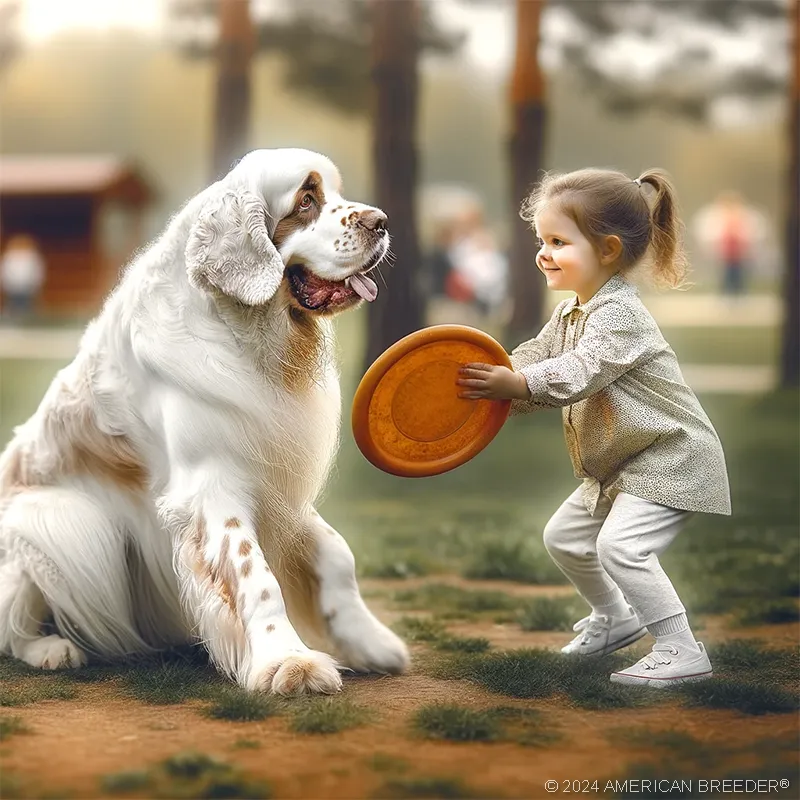Exploring the Gentle and Affectionate Nature of Clumber Spaniels
Introduction and Breed Background
 Welcome to the captivating world of the Clumber Spaniel Dog! With its regal appearance and endearing personality, this breed has been charming dog lovers for centuries. Let's embark on a journey to uncover the wonders and unique characteristics of this incredible canine companion.
Welcome to the captivating world of the Clumber Spaniel Dog! With its regal appearance and endearing personality, this breed has been charming dog lovers for centuries. Let's embark on a journey to uncover the wonders and unique characteristics of this incredible canine companion.
Brief Summary Description of Clumber Spaniel Dog: The Clumber Spaniel is a large, sturdy breed known for its distinctive appearance and gentle nature. Originating from France and the United Kingdom, these dogs were historically favored by the aristocracy for their exceptional bird hunting skills. Today, they make wonderful family pets and loyal companions, combining their hunting instincts with an affectionate demeanor.
Considerations Before Choosing Clumber Spaniel Dog: Before deciding to bring a Clumber Spaniel into your life, there are essential factors to consider. Their exercise needs, grooming requirements, and potential health issues should be thoroughly understood to ensure a happy and healthy life for your furry friend.
Interesting Facts and Fun Facts about Clumber Spaniel Dog:
Other Names for Clumber Spaniel: Clumber, Clumbers, Clumberdoodle (when crossed with a Poodle), Clum-dog. Some nicknames for Clumber Spaniel include, the Gentle Giant, and the Retriever of Kings.
Breed Background and History
Origin and Development of Clumber Spaniel Dog: The history of the Clumber Spaniel traces back to the late 18th century, with its name derived from Clumber Park, the estate of the Duke of Newcastle. It is believed that the breed's ancestors were brought from France to the United Kingdom during the French Revolution, where they were refined and developed into the Clumber Spaniels we know today.
Historical Significance or Cultural Relevance: Throughout history, Clumber Spaniels were cherished by nobility and royalty, earning their place as prized hunting companions. Their proficiency in flushing out game from dense cover made them highly valuable for bird hunting, a favored pastime of the elite.
Purpose or Original Use of Clumber Spaniel Dog: Originally bred for bird hunting, the Clumber Spaniel's primary purpose was to work alongside hunters to locate and retrieve game, especially in dense woodland areas. Their remarkable scenting abilities and strong retrieving instincts made them indispensable in the field.
Kennel Clubs that Classify, Group, or Register Clumber Spaniel Dog: The Clumber Spaniel is classified under the Sporting Group by various kennel clubs, including the American Kennel Club (AKC), The Kennel Club (UK), and the Canadian Kennel Club (CKC). These clubs play a crucial role in preserving breed standards and promoting responsible breeding practices.
Appearance
Size, Weight, Activity Level, and Physical Appearance: The Clumber Spaniel is a large breed with a robust build. Adult males typically weigh between 70 to 85 pounds, while females range from 55 to 70 pounds. Their stocky and low-slung body allows them to navigate dense cover with ease, and their powerful legs provide a steady gait.
Coat Type, Color Variations, and Patterns: Clumber Spaniels have a dense, straight coat that is weather-resistant, providing protection during their hunting expeditions. Their coat is predominantly white with lemon or orange markings on the ears and around the eyes. Their distinctive coat color and markings set them apart from other spaniel breeds.
Distinctive Features or Markings: One of the most noticeable features of the Clumber Spaniel is its heavy brow, which adds to its regal appearance. Additionally, they possess feathering on their ears, legs, chest, and tail, further enhancing their elegant look.
Average Litter Size for Clumber Spaniel: The typical litter size for Clumber Spaniels ranges from 6 to 8 puppies. Due to their large size, the mother requires special care during pregnancy and whelping to ensure the health and well-being of both the dam and her litter.
Temperament and Personality
Typical Temperament Traits and Behavior Tendencies: The Clumber Spaniel is renowned for its friendly and gentle nature. They are excellent with children and often form deep bonds with their families. Their affectionate and patient temperament makes them ideal companions for households with children and other pets. Energy Levels and Activity Requirements: While Clumber Spaniels are not excessively high-energy dogs, they do require regular exercise to maintain good health and prevent boredom-related behavioral issues. Daily walks, playtime, and mental stimulation are essential for their well-being.
Energy Levels and Activity Requirements: While Clumber Spaniels are not excessively high-energy dogs, they do require regular exercise to maintain good health and prevent boredom-related behavioral issues. Daily walks, playtime, and mental stimulation are essential for their well-being.
Compatibility with Different Lifestyles and Family Dynamics: The adaptability of Clumber Spaniels makes them suitable for a wide range of lifestyles. They can thrive in suburban homes, rural areas, and even apartments with sufficient exercise and mental stimulation.
List of Typical Behavior Issues:
Aggression and Biting: Early socialization and positive reinforcement training can help mitigate any aggressive tendencies.
Excessive Barking: Clumber Spaniels may bark when they feel anxious or bored. Proper training and mental enrichment can curb this behavior.
Digging Behavior: Boredom and excess energy may lead to digging behavior. Providing interactive toys and ample exercise can discourage this habit.
Separation Anxiety: Their affectionate nature may lead to separation anxiety. Gradual desensitization and training can alleviate this issue.
Resource Guarding: Clumber Spaniels may exhibit resource guarding behaviors. Positive reinforcement training can help address this behavior.
Fear and Phobias: Early socialization is crucial to prevent fear-based reactions to unfamiliar situations or people.
Trainability and Intelligence
Trainability Level and Ease of Learning: Clumber Spaniels are intelligent dogs that respond well to positive reinforcement training methods. They are eager to please their owners, making them relatively easy to train.
Willingness to Please Their Owner: Clumber Spaniels have a strong desire to please their human companions, which fosters a positive and rewarding training experience.
Intelligence and Problem-Solving Abilities: With their keen sense of smell and problem-solving skills, Clumber Spaniels excel in tasks that involve retrieving and tracking.
Recommended Training Approaches and Techniques: Positive reinforcement training, using rewards and praise, is highly effective with this breed. Harsh training methods can be counterproductive and should be avoided.
Training or Skills Best Suited for Clumber Spaniel: Given their hunting heritage, Clumber Spaniels excel in tracking, retrieving, and scent-based activities. They also make excellent therapy dogs due to their gentle and patient demeanor.
Practical Considerations
Size of Sleeping Quarters Depending on Size: Clumber Spaniels require adequate space to move comfortably. A cozy, cushioned dog bed or a dog crate that allows them to stretch out is recommended.
Typical Annual Veterinary Cost: The annual veterinary cost for a Clumber Spaniel can vary depending on their health and age. Regular check-ups, vaccinations, and preventive medications are essential to maintain their well-being. Type of Grooming and Annual Cost: Clumber Spaniels have moderate grooming needs. Regular brushing, ear cleaning, and occasional bathing will help keep their coat in good condition.
Type of Grooming and Annual Cost: Clumber Spaniels have moderate grooming needs. Regular brushing, ear cleaning, and occasional bathing will help keep their coat in good condition.
Daily Exercise Needs and Requirements: A mix of outdoor activities, such as brisk walks, playtime in the yard, and interactive games, is essential to meet their exercise needs. Mental stimulation, like puzzle toys and scent games, should also be incorporated to keep their intelligent minds engaged.
Level of Playfulness: Clumber Spaniels are playful and enjoy interactive games with their families. Their cheerful nature and love for play make them wonderful companions for children and adults alike.
Level of Intelligence: Ranked among the more intelligent dog breeds, Clumber Spaniels are quick learners and excel in various training activities. Their ability to comprehend commands and tasks makes them a joy to train.
Affection Level and Desired Attention: Clumber Spaniels are affectionate and thrive on human interaction. They form strong bonds with their families and enjoy being part of their daily activities.
Friendliness Toward Strangers: While Clumber Spaniels may be reserved with strangers, their gentle nature ensures they remain polite and well-mannered in social situations.
Grooming Needs and Frequency: The Clumber Spaniel's coat requires regular maintenance to prevent matting and to keep it clean and healthy. Weekly brushing is recommended, and additional grooming, such as ear cleaning and nail trimming, should be done as needed.
Feeding Requirements and Dietary Considerations: To keep your Clumber Spaniel in optimal health, provide them with a balanced diet suitable for their age, size, and activity level. Consult with a veterinarian to determine the appropriate portion sizes and dietary requirements for your specific dog.
Portion Sizes: Portion sizes should be based on the dog's age, weight, and activity level. Measuring meals and avoiding overfeeding is crucial to prevent obesity.
Feeding Schedule: A consistent feeding schedule helps maintain the Clumber Spaniel's digestive health and prevents grazing behaviors.
Recommended Dog Food Brands/Types: High-quality dog food that meets the nutritional needs of large breed dogs is ideal for Clumber Spaniels. Look for formulas with wholesome ingredients and avoid artificial additives.
Treats and Dietary Restrictions: Treats can be used as rewards during training, but moderation is key to avoid weight gain. Be mindful of any food allergies or sensitivities your dog may have and avoid giving them foods that could trigger a reaction.
Chapter 7: Health and Care
Common Health Issues or Predispositions of Clumber Spaniel: Like all breeds, Clumber Spaniels may be prone to certain health conditions. Common issues include hip dysplasia, eye problems (such as entropion and ectropion), and ear infections. Regular veterinary check-ups can help detect and manage these conditions early on.
Allergies and Specific Dietary Considerations: Clumber Spaniels may develop food allergies or environmental allergies, causing skin irritations and discomfort. Identifying and avoiding allergens can help manage these conditions effectively.
Lifespan and Longevity Expectations: On average, Clumber Spaniels have a lifespan of 10 to 12 years. Providing proper care, regular exercise, and a balanced diet can contribute to a longer and healthier life for your furry companion. Grooming Requirements Based on Coat Type and Size: The Clumber Spaniel's dense coat requires regular grooming to prevent matting and tangles. Their feathered ears, legs, and tail also need attention to keep them clean and free of debris.
Grooming Requirements Based on Coat Type and Size: The Clumber Spaniel's dense coat requires regular grooming to prevent matting and tangles. Their feathered ears, legs, and tail also need attention to keep them clean and free of debris.
Exercise Needs and Recommendations for Physical and Mental Stimulation: Meeting the exercise needs of Clumber Spaniels is essential for their overall well-being. Engaging them in various physical and mental activities will keep them happy and prevent boredom-related behaviors.
Nutrition and Feeding Guidelines: A nutritious and balanced diet is crucial to support the Clumber Spaniel's overall health and vitality. Consult with a veterinarian to determine the appropriate diet plan for your individual dog.
Vaccination Schedule and Preventive Care: Following a regular vaccination schedule is vital to protect your Clumber Spaniel from common canine diseases. Preventive care, such as flea and tick prevention, heartworm medication, and regular dental check-ups, should also be part of their healthcare routine.
Core Vaccines: Core vaccines for Clumber Spaniels typically include rabies, distemper, parvovirus, and adenovirus.
Non-Core Vaccines: Non-core vaccines may be recommended based on your dog's lifestyle and exposure risks. Examples include vaccines for Bordetella (kennel cough) and Leptospirosis.
Flea and Tick Prevention: Regular use of flea and tick prevention products helps protect your dog from these common parasites.
Heartworm Prevention: Heartworm prevention medication is essential to safeguard your Clumber Spaniel from this potentially deadly parasite.
Regular Health Check-ups and Vet Visits: Routine veterinary check-ups are vital for early detection of health issues and to ensure your dog receives the necessary preventive care.
Signs of Potential Health Problems and When to Seek Veterinary Attention: Being attuned to your Clumber Spaniel's behavior and health is crucial for detecting any signs of illness or discomfort. If you notice any changes in their eating habits, behavior, or physical appearance, consult your veterinarian promptly.
Chapter 8: Socialization and Compatibility
Interaction with Children, Other Pets, and Strangers: Clumber Spaniels are known for their gentle and friendly nature, making them excellent companions for children and other pets. Early socialization plays a vital role in shaping their behavior and interactions with others. Socialization Needs and Tips for Proper Socialization: Exposing Clumber Spaniels to different environments, people, and animals during their formative months helps them become well-adjusted and confident adults.
Socialization Needs and Tips for Proper Socialization: Exposing Clumber Spaniels to different environments, people, and animals during their formative months helps them become well-adjusted and confident adults.
Precautions or Considerations for Multi-Dog Households: When introducing a new Clumber Spaniel to a multi-dog household, gradual introductions and supervised interactions are recommended to ensure a harmonious pack dynamic.
Level of Ease When It Comes to Training Clumber Spaniel: Clumber Spaniels' friendly and cooperative nature makes them relatively easy to train. Early and consistent training will ensure they develop good manners and positive behaviors.
Playtime and Exercise with Other Dogs or Pets: Clumber Spaniels generally enjoy the company of other dogs and pets, provided they are properly introduced and socialized.
Dog-Friendly Activities and Outings: Clumber Spaniels love spending time outdoors with their families. Activities like walks, hikes, and visits to dog-friendly parks are enjoyable ways to bond and keep them mentally stimulated.
Living Arrangements and Environment
Suitability for Different Living Arrangements: Clumber Spaniels can adapt to various living arrangements, from urban apartments to spacious rural homes. However, they thrive in environments where they have access to outdoor space for play and exercise.
Space Requirements and Exercise Options: While Clumber Spaniels can live in apartments, access to a yard or nearby parks is essential to meet their exercise needs.
Climate Considerations and Adaptability: Clumber Spaniels have a thick, water-resistant coat that offers some protection from extreme weather conditions. However, it's essential to provide them with proper shelter and avoid excessive exposure to extreme temperatures.
Recommended Yard Size for Clumber Spaniel: A medium to large yard with enough space for the Clumber Spaniel to move freely and play is ideal. Fenced yards are especially beneficial for off-leash play and to prevent them from wandering off.
Ideal Living Conditions and Environment: Clumber Spaniels thrive in homes with loving and attentive families who can provide them with the attention, exercise, and mental stimulation they need. They are content when surrounded by affectionate owners and other pets.
Training and Obedience
 Basic Obedience Training and Commands:
Basic Obedience Training and Commands:
Teaching Clumber Spaniels basic obedience commands such as sit, stay, come, and heel is essential for a well-behaved and obedient companion. Positive reinforcement methods are highly effective in their training.
Advanced Training or Specialized Activities Suited for Clumber Spaniel:
Due to their hunting background, Clumber Spaniels excel in advanced training such as scent tracking, retrieving, and fieldwork. They also make excellent therapy dogs, providing comfort and support to those in need.
Behavioral Challenges or Specific Training Considerations:
Like any breed, Clumber Spaniels may exhibit behavioral challenges such as excessive barking, digging, or resource guarding. Consistent and patient training, combined with positive reinforcement, can address these challenges effectively.
House Training and Potty Training Tips:
House and potty training should begin early on. Establish a routine for feeding and bathroom breaks, and reward your Clumber Spaniel for eliminating in the appropriate spot.
Leash Training and Walking Etiquette:
Leash training is crucial to ensure that Clumber Spaniels walk calmly and politely on the leash. Positive reinforcement and consistency will help them become excellent walking companions.
Exercise and Activity
Daily Exercise Needs and Recommendations: Clumber Spaniels require regular exercise to maintain their physical and mental well-being. Aim for at least one hour of exercise each day, which can include walks, playtime, and engaging activities.
Mental Stimulation Activities and Games: Engaging Clumber Spaniels in mental stimulation games and puzzles helps prevent boredom and provides an outlet for their intelligence. Activities such as hide-and-seek, puzzle toys, and scent games are excellent choices.
Exercise Routines and Activity Ideas: Create a diverse exercise routine that includes walks, playtime, fetch, and off-leash time in a secure area. Introduce new activities to keep them mentally challenged and entertained.
Energy Outlets for High-Energy Breeds: For Clumber Spaniels with high energy levels, consider activities that channel their energy constructively, such as agility training, flyball, or dock diving.
Financial Planning
 Typical Price Range for Purchasing Clumber Spaniel from Reputable Breeders: The cost of a Clumber Spaniel from a reputable breeder can vary depending on factors such as the breeder's location, the dog's lineage, and any additional services provided.
Typical Price Range for Purchasing Clumber Spaniel from Reputable Breeders: The cost of a Clumber Spaniel from a reputable breeder can vary depending on factors such as the breeder's location, the dog's lineage, and any additional services provided.
Initial Costs (Adoption Fees or Purchase Price, Vaccinations, Spaying/Neutering, Microchipping): Initial costs for bringing a Clumber Spaniel into your home include the adoption or purchase fee, vaccinations, spaying/neutering, and microchipping.
Ongoing Expenses (Food, Grooming, Veterinary Care, Training, Toys, and Supplies): Ongoing expenses for Clumber Spaniels encompass food, grooming supplies, veterinary care, training classes, toys, and other necessary supplies.
Considerations for Pet Insurance or Budgeting for Unexpected Medical Costs: Pet insurance is an excellent option to prepare for unexpected medical expenses. Setting aside a budget for emergencies ensures you can provide the best care for your Clumber Spaniel if the need arises.
Options for Pet Care During Vacations or Travel: Plan for pet care during vacations or travel by arranging for a trusted pet sitter, boarding facility, or enlisting the help of friends or family members.
Overall Summary
Clumber Spaniels are gentle, affectionate, and intelligent dogs with a rich history as loyal hunting companions. Consideration should be given to their exercise needs, grooming requirements, and socialization to ensure their well-being. Positive reinforcement training techniques are effective for their obedience and behavioral development. Responsible ownership involves ethical breeding choices and providing a loving, suitable home for your Clumber Spaniel.
Highlight Interesting and Fun Facts about Clumber Spaniel:
Clumber Spaniels were a favorite of British royalty, including Prince Albert and King Edward VII.
They were historically used for retrieving game, including hunted birds, from the dense undergrowth.
Clumber Spaniels have a distinctive rolling gait and a keen sense of smell that aids in their hunting abilities. Capture the Breed's Unique Characteristics and Appeal: Clumber Spaniels possess a captivating blend of gentle demeanor, intelligence, and playfulness. Their affectionate nature and willingness to please make them ideal family pets.
Capture the Breed's Unique Characteristics and Appeal: Clumber Spaniels possess a captivating blend of gentle demeanor, intelligence, and playfulness. Their affectionate nature and willingness to please make them ideal family pets.
Create Excitement and Enthusiasm for Potential Dog Owners: Prospective owners should be thrilled at the prospect of welcoming a Clumber Spaniel into their homes. The breed's unique qualities and potential for a loving, lifelong bond make them a wonderful addition to any family.
Conclusion
Summary of Key Information and Considerations for Clumber Spaniel: In conclusion, Clumber Spaniels are charming, affectionate, and intelligent dogs with a fascinating history as skilled hunting companions. Prospective owners should be aware of their exercise needs, grooming requirements, and the commitment required for responsible ownership.
Encouragement to Continue Learning and Seeking Expert Guidance: As you embark on your journey with a Clumber Spaniel, continue learning about their unique needs and characteristics. Seek expert guidance from veterinarians, trainers, and experienced Clumber Spaniel owners to provide the best care for your furry companion.
Emphasis on Responsible Ownership, Commitment, and Providing a Loving, Suitable Home for a Dog: Responsible ownership of a Clumber Spaniel entails commitment, patience, and love. Provide them with a nurturing environment, training, and socialization to ensure a happy and fulfilling life for your canine companion.
With this comprehensive and informative guide, potential Clumber Spaniel owners can embark on a wonderful journey with this exceptional canine companion. Embrace the joy of having a loyal, affectionate, and intelligent friend by your side, and create lasting memories filled with love and laughter.
Clumber Spaniel Dog Quick Reference Guide
Breed Background: Origin: France/UK | Breed Purpose: Bird hunting | AKC Class: Sporting Group | Year Recognized by AKC: 1884
 Appearance: Size: Large | Weight: 55-85 lbs | Coat Type: Dense, straight | Colors & Patterns: White with lemon or orange markings | Distinctive Features: Heavy brow and feathered coat
Appearance: Size: Large | Weight: 55-85 lbs | Coat Type: Dense, straight | Colors & Patterns: White with lemon or orange markings | Distinctive Features: Heavy brow and feathered coat
Temperament: Energy Level: 3 | Friendliness to Pets: 4 | Friendliness to Strangers: 3 | Trainability: 3 | Playfulness: 3 | Frequent Barker: 2 | Chase Instincts: 4 | Sense of Smell: 5 | Drive to Hunt: 5
Health & Care: Health Issues: Hip dysplasia, eye conditions | Lifespan: 10-12 years | Grooming Difficulty: Moderate | Exercise Needs: Moderate
Socialization: Interaction with Children: Good-natured and gentle | Interaction with Pets: Generally gets along well | Interaction with Strangers: Reserved, but polite | Ease of Training: Moderate
Suitable Living Arrangements: Apartment: Not ideal | House: Yes | Rural Area: Preferred | Yard Size Requirements: Medium to large yard
Training & Obedience: Trainability: 3 | Intelligence: 4 | Obedience: 3 | Problem-Solving: 3 | Easily Stimulated: 3 | Focus Level: 3 | Easily Distracted: 2
Financial Planning: Typical Price Range: $1,500 - $3,000 | Initial Expenses: Puppy essentials, training classes | Ongoing Annual Expenses: Food, vet visits
Breeding: Reproductive Maturity: 18-24 months | Litter Frequency: Once per year | Litter Size: 6-8 puppies | Stud Cost: $800 - $1,500 | Breeding Challenges: Whelping difficulties
Did You Enjoy this Article? Share it and Help Us Spread the Word!
If you found this article helpful, we'd appreciate it if you could share it with your friends or link to it from your website, blog, or group! You can also use the convenient social share tabs on the left side of the screen to instantly share this page to your social media feed. For more ways to support and promote the American Breeder Community, visit our Share & Promote Together page for social media posts and memes you can copy and share. Your support means the world to us!
Disclaimer: The information provided in this article is for general informational purposes only and does not constitute legal, medical, financial, or professional advice. While we strive for accuracy, we make no representations or warranties regarding the completeness, accuracy, reliability, or suitability of the information. Please consult with a professional before making decisions based on the content provided. American Breeder Inc. assumes no responsibility for any errors or omissions or for the results obtained from the use of this information.
